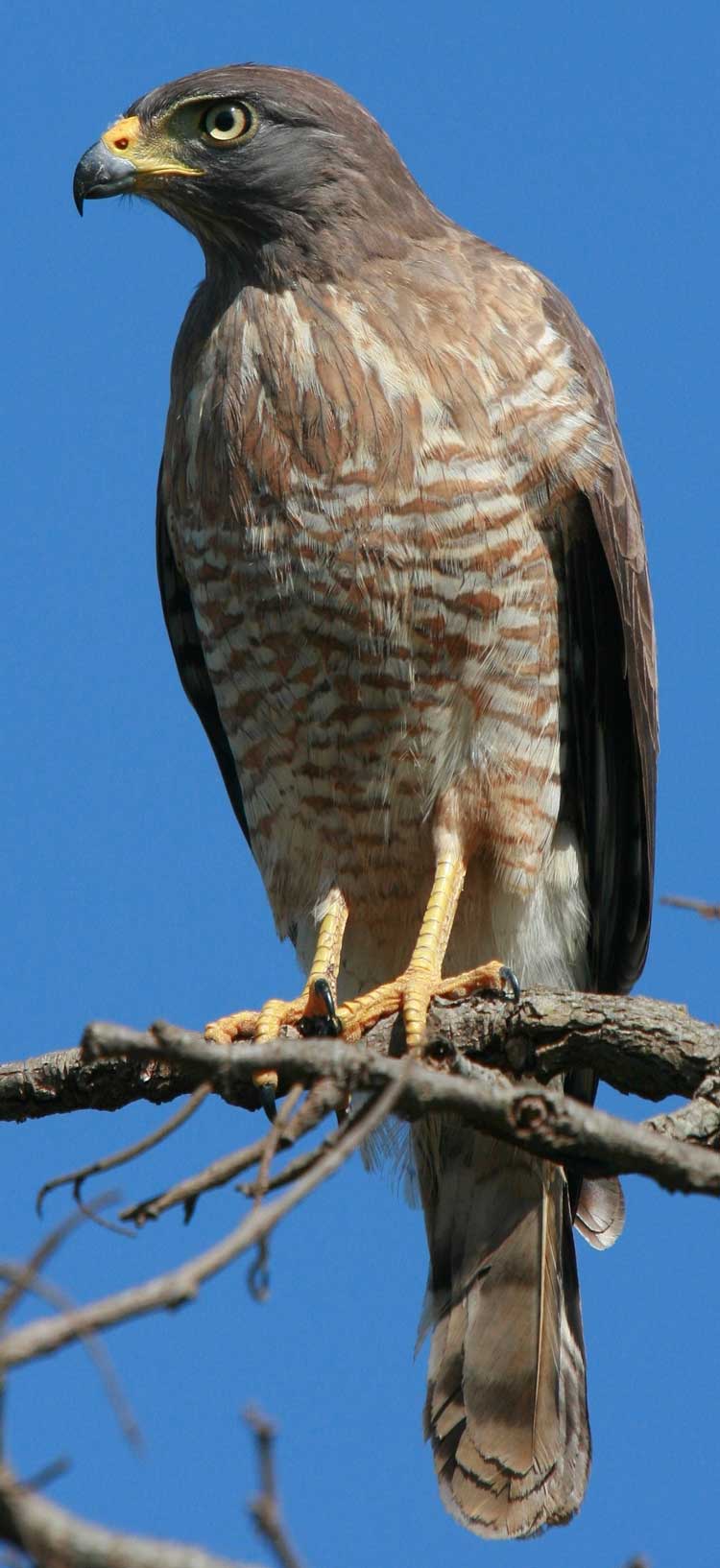
Rupornis magnirostris (*)
Cladus: Eukaryota
Supergroup: Opisthokonta
Regnum: Animalia
Subregnum: Eumetazoa
Cladus: Bilateria
Cladus: Nephrozoa
Cladus: Deuterostomia
Phylum: Chordata
Subphylum: Vertebrata
Infraphylum: Gnathostomata
Superclassis: Tetrapoda
Classis: Aves
Subclassis: Carinatae
Infraclassis: Neornithes
Parvclassis: Neognathae
Ordo: Falconiformes
Familia: Accipitridae
Subfamilia: Buteoninae
Genus: Rupornis
Species: Rupornis magnirostris
Subspecies: R. m. alius - R. m. conspectus - R. m. gracilis - R. m. griseocauda - R. m. magniplumis - R. m. magnirostris - R. m. nattereri - R. m. occiduus - R. m. petulans - R. m. pucherani - R. m. saturatus - R. m. sinushonduri
Name
Rupornis magnirostris (Gmelin, 1788)
Synonyms
* Buteo magnirostris
Reference
* Original citation: Systema Naturae 1 pt1 p.282
* Riesing MJ, Kruckenhauser L, Gamauf A, Haring E. 2003. "Molecular phylogeny of the genus Buteo (Aves: Accipitridae) based on mitochondrial marker sequences." Molecular Phylogenetics and Evolution 27:328-342. [1]
Vernacular names
Česky: Káně krahujová
English: Roadside Hawk
Español: Busardo caminero
Polski: Myszołów krzykliwy
Português: Gavião-carijó
-----------
The Roadside Hawk (Buteo magnirostris) is a relatively small bird of prey found in Latin America.
The breast and underparts of the bird are barred brown and white, and the tail has four or five grey bars. There is significant plumage variation depending on the subspecies. At least twelve subspecies have been recognised. The eyes of the Roadside Hawk are usually yellow, and although the bird's general colour is grey, it is fairly common to observe a touch of rufous (i.e., a light brownish coloration) on the bird's wings, specially when it is in flight.[1] Its call is a very high-pitched piercing squeak.
Fairly small compared to other members of the genus Buteo, being 36 centimeters in average length, the Roadside Hawk can in some parts of its range be identified by its long tail and disproportionately short wings.
The Roadside Hawk common throughout its range: from Mexico through Central America to most of South America east of the Andes cordillera. It is found from the northern Caribbean coast of South America south to the northeastern parts of Argentina. With the possible exception of dense forests, the Roadside Hawk is well adapted to most ecosystems in its range. It is also an urban bird, and is possibly the most common species of hawk seen in various cities throughout its range – or perhaps just the most conspicuous one, as it becomes aggressive when nesting and has been recorded attacking humans passing near the nest.[2]
The Roadside Hawk's diet consists mainly of insects, squamates, and smallish mammals, such as young Common Marmosets and similar small monkeys which are hunted quite often[3]. It will also take small birds, but far less often than generalists such as the related but larger White-tailed Hawk) or bird specialists like the more distantly related Aplomado Falcon. Mixed-species feeding flocks it encounters when hunting in open cerrado habitat are not particularly wary of it: they watch it lest the hawk come too close, but consider them hardly more of a threat than the diminutive American Kestrel.[4]
Taxonomy
The sub-species and their distributions are:
* B. m. griseocauda Ridgway, 1873 - Mexico (S from Colima, Nuevo León and Tamaulipas, except Yucatán and Tabasco) S to NW Costa Rica and W Panama (Chiriquí).
* B. m. conspectus (Peters, 1913) - SE Mexico (Tabasco and Yucatán Peninsula) and N Belize.
* B. m. gracilis (Ridgway, 1885) - Cozumel I and Holbox I, near Yucatán (Mexico).
* B. m. sinushonduri Bond, 1936 - Bonacca I and Ruatan I, off Honduras.
* B. m. petulans van Rossem, 1935 - SW Costa Rica and Pacific slope of W Panama to R Tuira, and adjacent islands.
* B. m. alius (Peters & Griscom, 1929) - San José and San Miguel, in Pearl Is (Gulf of Panama).
* B. m. magnirostris (Gmelin, 1788) - Colombia S to W Ecuador, E to Venezuela and the Guianas, and S to Amazonian Brazil (R Madeira E to Atlantic coast).
* B. m. occiduus (Bangs, 1911) - E Peru, W Brazil (S of Amazon, W of R Madeira) and N Bolivia.
* B. m. saturatus (P. L. Sclater & Salvin, 1876) - Bolivia, through Paraguay and SW Brazil (SW Mato Grosso) to W Argentina (S to La Rioja).
* B. m. nattereri (P. L. Sclater & Salvin, 1869) - NE Brazil S to Bahia.
* B. m. magniplumis (Bertoni, 1901) - S Brazil, N Argentina (Misiones) and adjacent Paraguay.
* B. m. pucherani (J. & E. Verreaux, 1855) - Uruguay and NE Argentina (S to Buenos Aires Province).
References
1. ^ As illustrated in Frisch and Frisch (2005): p. 191.
2. ^ BLI (2008), Pereira (2008): p. 41.
3. ^ de Lyra-Neves et al. (2007)
4. ^ Ragusa-Netto (2000).
Cited texts
* Frisch, J.D. & Frisch, C.D. (2005). Aves Brasileiras e Plantas que as Atraem [Brazilian birds and plants attractive to them] - fieldguide. Dalgas Ecotec, São Paulo [In Portuguese]. ISBN 85-85015-07-1
* BirdLife International (BLI) (2008). Buteo magnirostris. In: IUCN 2008. IUCN Red List of Threatened Species. Downloaded on 16 November 2008.
* de Lyra-Neves, Rachel M.; Oliveira, Maria A.B.; Telino-Júnior,Wallace R. & dos Santos, Ednilza M. (2007): Comportamentos interespecíficos entre Callithrix jacchus (Linnaeus) (Primates, Callitrichidae) e algumas aves de Mata Atlântica, Pernambuco, Brasil [Interspecific behaviour between Callithrix jacchus (Linnaeus) (Callitrichidae, Primates) and some birds of the Atlantic forest, Pernanbuco State, Brazil]. Revista Brasileira de Zoologia 24(3): 709–716 [Portuguese with English abstract]. doi:10.1590/S0101-81752007000300022 PDF fulltext.
* Pereira, José Felipe Monteiro (2008). Aves e Pássaros Comuns do Rio de Janeiro ["Common birds of Rio de Janeiro"]. Technical Books Editora, Rio de Janeiro [In Portuguese]. ISBN 978-8561368-00-5
* Ragusa-Netto, J. (2000): Raptors and "campo-cerrado" bird mixed flock led by Cypsnagra hirundinacea (Emberizidae: Thraupinae). Revista Brasileira de Biologia 60(3): 461-467 [English with Portuguese abstract]. doi:10.1590/S0034-71082000000300011 PDF fulltext
Retrieved from "http://en.wikipedia.org/"
All text is available under the terms of the GNU Free Documentation License

